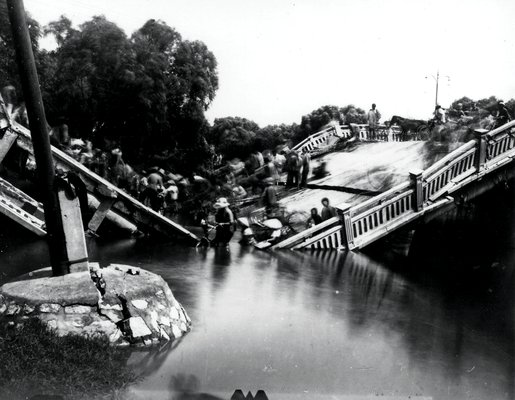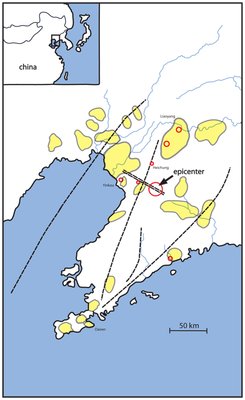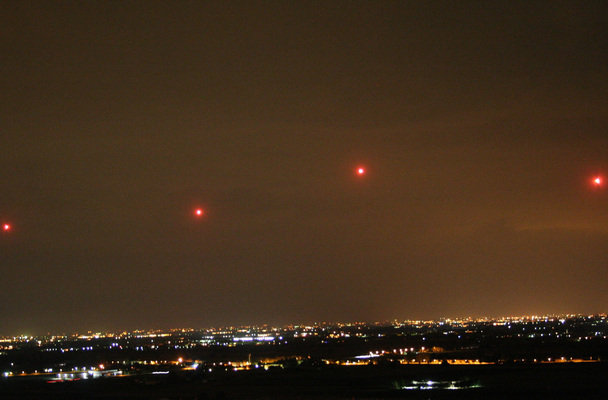
by Brian Fisher Johnson Thursday, January 5, 2012

A collapsed bridge after the Tangshan, China, earthquake on July 28, 1976, which killed more than 240,000 people. Although Chinese seismologists 'successfully' predicted the Haicheng quake of 1975, they failed to forecast this one. USGS

After the Haicheng quake, a Chinese seismologist produced this map of strange animal behavior (circled areas) and earthquake fractures (dotted lines). Helmut Tributsch and The MIT Press for the English language edition

Luminous dots over Parma, Italy, on August 10, 2007. Five days later, there was a small magnitude-2.9 quake. The dots may be ionized air from shifting faults, proponents of earthquake prediction say. GAZETTA DI PARMA - Italy
The 1990s and early 2000s were hard times for earthquake prediction research. “For 10 years, there was limited funding in the U.S.,” says Dimitar Ouzounov, a research scientist at NASA’s Goddard Space Flight Center in Greenbelt, Md., and professor at Chapman University in Orange, Calif. That changed in 2004, Ouzounov says, after a magnitude-9-plus quake struck off the coast of Sumatra and set off a tsunami, killing more than 225,000 people in 11 countries.
It was a seminal moment in earthquake research, Ouzounov says. “It actually showed we were not able to get in advance any information on the biggest event of the last 100 years.”
Improving that information, according to Ouzounov, should include research on geophysical anomalies that precede large seismic events — regional, days-long increases in temperature or alterations in the electromagnetic field — that could one day act as warnings of major earthquakes.
Many researchers have failed to validate these signals for centuries. Some scientists have deemed them a useless cause. But after the disaster that befell Sumatra, quake prediction research has regained demand — and funding.
In Europe, accounts of strange animal behavior before earthquakes go back to ancient Greece. But such signals didn’t win serious scientific attention until 1975, when Chinese officials “successfully” predicted a major earthquake near the city of Haicheng, about 550 kilometers northeast of Beijing.
Based on the surrounding province’s 2,200-year earthquake history and an array of geological measurements, China’s National Earthquake Bureau concluded in 1974 that a major earthquake would strike the area within the next two years, wrote physical chemist Helmut Tributsch in “When the Snakes Awake: Animals and Earthquake Prediction.” Determined to avoid the worst, the bureau not only expanded its measurement network, but trained more than 100,000 “honorary observers” to spot signs of an impending quake: Animals might leave their borrows, they were told. Well waters might cloud up and bubble. Lightning might strike from clear skies. Furthermore, the National Earthquake Bureau maintained, a small earthquake would strike north of the future “big one.”
After a minor quake struck just 70 kilometers north of Haicheng in December 1974, reports of unusual phenomena began streaming in: “Geese flew into trees,” Tributsch writes. “Pigs bit at each other or dug beneath the fences of their sties … Gas bubbles appeared in the pond water.” After a swarm of small quakes struck throughout the region in early February 1975, officials began evacuating Haicheng in full swing by 2 p.m. on Feb. 4, placing people in emergency shelters and herding animals from their stables.
Then, around 7:36 that night, the quake hit. It was a magnitude 7.3, large enough to destroy or severely damage about 50 percent of the buildings in the region. Although the quake’s destruction killed 2,041 people, as many as 150,000 deaths and injuries might have occurred if not for officials’ well-timed evacuation, according to the U.S. Geological Survey.
Scientific commissions from around the world converged on the scene to investigate the “successful prediction.” Though the Chinese admitted they had little explanation for the usefulness of animal behavior as earthquake precursors, Tributsch writes that one Chinese seismologist told a colleague from Caltech that animal observation was “the best method for earthquake prediction thus far.”
Following the Haicheng quake, other reports of advances in earthquake prediction appeared, including some from the former Soviet Union, says John Filson, a geologist emeritus at USGS in Reston, Va. By 1976, the U.S. National Research Council was convinced, concluding in a report that with “the appropriate commitment and level of effort,” earthquake prediction “may be possible within 10 years in well-instrumented areas.”
Of course, there were other, more scientific criteria than the animal behavior sightings used in the Haicheng quake. In a 1973 Science paper, scientists at Columbia University’s Lamont-Doherty Geological Observatory in Palisades, N.Y., argued that parameters such as “tilt, fluid pressure, electrical and magnetic fields, radon emission, the frequency of occurrence of small local quakes, and the ratio of the number of small to large shocks” could, with enough diligence, elicit reliable signals of upcoming quakes. They might even explain all those strange pre-quake phenomena people had reported over the centuries. For example, Tributsch explained in a 1978 paper in Nature that strongly charged air and particulates had been linked to “serotonin irritation syndrome,” in mammals, “fog in air with less than 100 percent humidity” and “light-producing electrical discharges.”
By 1977, Filson says, Congress established the National Earthquake Hazards Reduction Program. Up to half of the new program’s $30 million budget was to be spent on earthquake prediction research. It was a scientific free-for-all. “People were measuring everything from cockroach activity to radon emissions, seismic patterns to strange electrical currents,” recalls Filson, chief of the USGS Office of Earthquake Studies at the time.
And knowing whether to issue a warning from those parameters was no easy task, Filson says. “I’d get these calls when I was at the dinner table saying, ‘John, we’ve seen this big signal from our machine or from our data, you’d better do something.’ And we’d talk about it, and the final comment would be, ‘Well you’d better do something. What are you going to do?’ … It was a terrible position to be in.”
More often than not, Filson says, those “signals” proved faulty. “Two or three days would pass [with no earthquake], and then I’d call this person back and I’d say, ‘What happened?’ And he’d say, ‘Our capacitor burnt out’— it was a spurious signal from some electronic failure.”
Even the most exacting experiments failed to produce results. In the mid-1980s, scientists predicted a four-year window within which an earthquake should occur on the San Andreas Fault near Parkfield, Calif., based on a roughly 22-year recurrence cycle. The quake did not occur. (One eventually did occur in 2004, although no obvious precursors were observed, Filson says.) Furthermore, claims of enhanced magnetic field levels prior to the 1989 Loma Prieta earthquake in San Francisco also faced steep suspicion (and were recently shown to be the result of a sensor system malfunction according to a 2009 paper in the journal Physics of the Earth and Planetary Interiors). By the mid-1990s, the National Earthquake Prediction Evaluation Council had fallen into inactivity. By 1997, a seismologist wrote in a review of precursor research in Geophysical Journal International that earthquake prediction was “effectively impossible.”
Since then, for the most part, scientists have settled for the next best things. Earthquake hazard assessments, for example, use past earthquake history to estimate the probability that a quake of a particular magnitude will occur in an area within a given period. And earthquake early warning systems can, when they work right, give regions up to a minute’s warning of approaching shock waves from a faraway quake — enough time to stop a train or shut down nuclear power plants. “That’s an achievement, of course,” Ouzounov says. “But,” he adds, “it’s limited.”
After the 2004 Sumatra earthquake and tsunami, quake prediction was back in demand. In 2006, for example, the National Earthquake Prediction Evaluation Council was re-established. Ouzounov’s current research at NASA is also part of that trend. Ouzounov is working with NASA colleague Patrick Taylor to study thermal anomalies in regions of major earthquakes from satellite and ground-based data.
That coupling of quakes with atmospheric temperatures is based on gas discharges according to Ouzounov and his colleagues: Uranium-bearing rocks in Earth’s crust emit minute amounts of radon, a colorless, odorless gas that forms from the decay of radium. As faults shift in the days leading up to an earthquake, they create new openings from which radon can escape. That excess radon, in turn, releases alpha particles that tinge the atmosphere with ionic charge and allow the formation of aerosol-sized particles as ions mix with water.
And it is the latent heat from that chain of physical processes, Ouzounov hypothesizes, that satellites could pick up as thermal anomalies preceding some major earthquakes.
It’s a verifiable concept based on fundamental principles in atmospheric physics, Ouzounov says. Formation of aerosol-sized particles could also explain other precursor phenomena, such as earthquake fog and unusual clouds formation. Ouzounov and his colleagues have even found Earth radiation anomalies one to two months before the Sumatra earthquake, with a maximum signal two weeks before the quake.
But, Ouzounov says, such findings by no means authenticate earthquake precursors. “We need to show more statistical validation of the results,” Ouzounov says. “We’d like to show continuous observation, not just a case-by-case study.”
And even if precursors were validated statistically, Ouzounov says, such a finding would not match the level of earthquake prediction envisioned by scientists in the past. “The approach of validating the earthquake atmospheric precursors is not very different from the methodology used in weather forecasting,” he says. “Statistically, the weather forecast for Washington, D.C., is about 80 percent reliable during the winter.” Thermal electromagnetic anomalies, on the other hand, have not shown nearly that kind of reliability in correlation with major earthquakes on a global scale. As a result, Ouzounov says that any “validated” precursors would likely supplement, not replace, current earthquake early warning systems.
In the meantime, research on earthquake precursors has improved quite a bit since the 1970s and 1980s. Instead of the single sensor that may have incorrectly detected changes in the magnetic field before the Loma Prieta earthquake, Ouzounov says, geophysicists can now test research and observations against multiple satellites and ground-based monitoring networks measuring numerous parameters. And other scientists — though still skeptical — are showing interest.
Last fall, Ouzounov and colleagues invited seismologists and atmospheric scientists to listen to the latest developments in earthquake precursor research at the annual meeting of the American Geophysical Union in San Francisco, Calif. With an international collaboration of experts working on different aspects of this issue, Ouzounov says, scientists can better evaluate earthquake anomalies. In short, he says, “we are on the quest for validation.”
Ouzounov has his work cut out for him. “If we’ve learned one thing over the last several decades,” says Michael Blanpied, associate coordinator for the USGS Earthquake Hazards Program in Reston, Va., and a member of the National Earthquake Prediction Evaluation Council, it is “that the kinds of observations that may lead to earthquake prediction are going to be very subtle. Proof that there is predictability is going to require … a great deal of work to demonstrate to the scientific community that it’s true.”
But the issue of earthquake prediction is more complicated than that, Blanpied says, because even if geoscientists could declare with high certainty that a large quake was 24 hours away, it doesn’t address one big social question: What measures would officials need to take? Twenty-four hours is still a short amount of time to prepare a highly populated area for an earthquake. Without a specific plan to evacuate, Blanpied says, mass panic could ensue.
Filson knows this from experience. In 1980, a scientist at the U.S. Bureau of Mines announced that a major quake would strike Lima, Peru, around June 28, 1981. The National Earthquake Prediction Evaluation Council determined that the finding was based on questionable theoretical assumptions, and responded that members of the council were so confident that a quake would not occur during the proposed four-day window around the date, that they would have no fear of being in Lima during the prediction window. Filson went to Peru, where he tried to calm citizens via television and newspaper interviews.
Filson’s message proved correct; no earthquake hit. But at a dinner at the U.S. embassy, he discovered his assurances had been in vain. At first, Filson thought the tuna sandwiches served by the ambassador and his wife were an attempt to save taxpayer money. Then the ambassador’s wife revealed that all of the indigenous staff at the embassy, including the cooks, had left Lima for their hometowns — to die with their families.
No one died, obviously, but the question remains whether earthquake prediction will ever be correct enough to create solutions and not panic.
© 2008-2021. All rights reserved. Any copying, redistribution or retransmission of any of the contents of this service without the expressed written permission of the American Geosciences Institute is expressly prohibited. Click here for all copyright requests.